Are you tired of using the same old beauty products with no room for creativity? Look no further than natural cosmetic waxes! These versatile waxes can be used in a variety of beauty products, from lip balms to lotion bars, and offer a range of benefits for your skin. But how do you take your natural cosmetic wax game to the next level? Join us as we reveal expert tips and tricks to get creative with natural cosmetic waxes. From customizing scents to experimenting with unique textures, this guide will unlock your inner beauty product artist and help you create truly one-of-a-kind beauty products. Don’t settle for boring, cookie-cutter beauty products. Get creative with natural cosmetic waxes today and discover a whole new world of beauty possibilities!
Unlocking the Secrets of Natural Cosmetic Wax Formulations
What is a wax?
Waxes are a fascinating class of lipids that have been used for centuries in a variety of applications, including cosmetics, candles, and even art. Chemically speaking, waxes are a unique combination of hydrocarbons and fatty esters, which are formed by the reaction between a fatty acid and a fatty alcohol. This unique chemical composition gives waxes their characteristic properties, including their ability to add texture, viscosity, and stability to skincare products. From beeswax to carnauba wax, each natural wax has its own distinct chemical makeup and set of benefits, making them an essential ingredient in modern cosmetic formulations. Whether you’re a skincare formulator or simply a lover of natural beauty products, understanding the science behind waxes can help you appreciate their versatility and importance in the world of cosmetics.
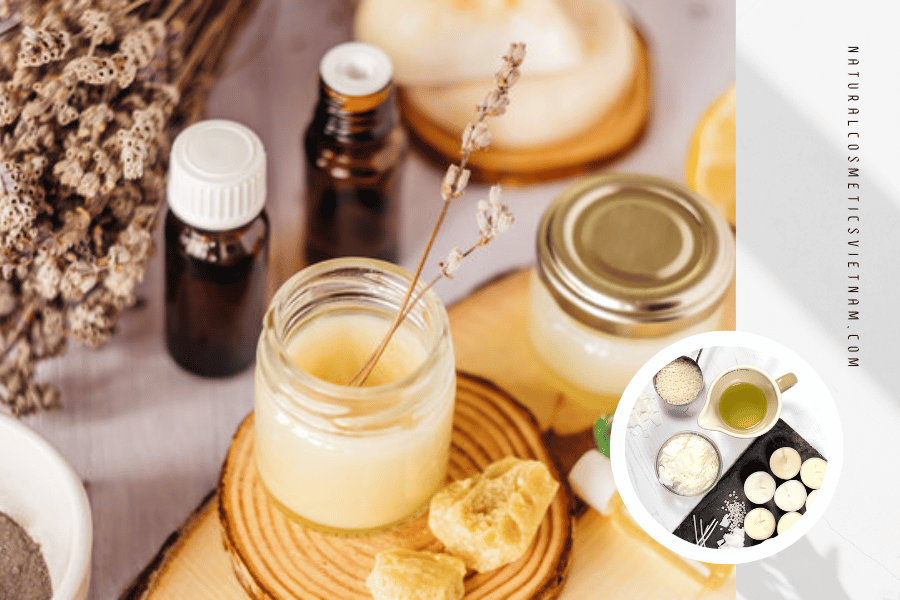
Waxes are a fascinating class of lipids that have been used for centuries in a variety of applications, including cosmetics
The benefits of waxes in natural cosmetics
Natural cosmetic waxes have become increasingly popular in the world of organic skincare. Not only are they versatile and multi-functional, but they offer a range of benefits for our skin. In this article, we’ll take a closer look at the important roles natural waxes play in our cosmetic formulations and explore some of the most popular natural waxes used in organic skincare today.
Improving Texture
Improving texture is one of the key benefits of natural waxes in skincare formulations. Natural waxes can help create a smooth and creamy texture that is easy to apply and feels great on the skin. This is especially important in products like lotions and creams, where texture can make all the difference in how the product feels and performs. Whether you’re making a lotion or a lip balm, natural waxes can help create a smooth and creamy texture that is easy to apply and feels great on the skin. The texture of a product can make all the difference in how it feels and performs, so the addition of natural waxes is a key factor in creating high-quality skincare products.
One of the most commonly used natural waxes for improving texture is beeswax. Beeswax has a unique texture that helps create a smooth and creamy consistency in products. It is also a natural emulsifier, which means it can help bind oil and water-based ingredients together in a product. In addition to beeswax, there are several other natural waxes that can improve texture in skincare products. Candelilla wax, for example, is a vegan alternative to beeswax that is known for its ability to create a smooth and creamy texture in products. It is often used in lip balms and other skincare products to create a soft and easy-to-apply consistency. Another natural wax that can improve texture is carnauba wax. This hard, brittle wax is derived from the leaves of the carnauba palm and is often used in skincare products as a natural thickener and emulsifier. Carnauba wax can help create a smooth and creamy texture in products while also providing a protective barrier on the skin.
In addition to improving texture, natural waxes can also improve the overall feel of a product. They can create a luxurious and indulgent experience for the user, making skincare routines more enjoyable and effective.
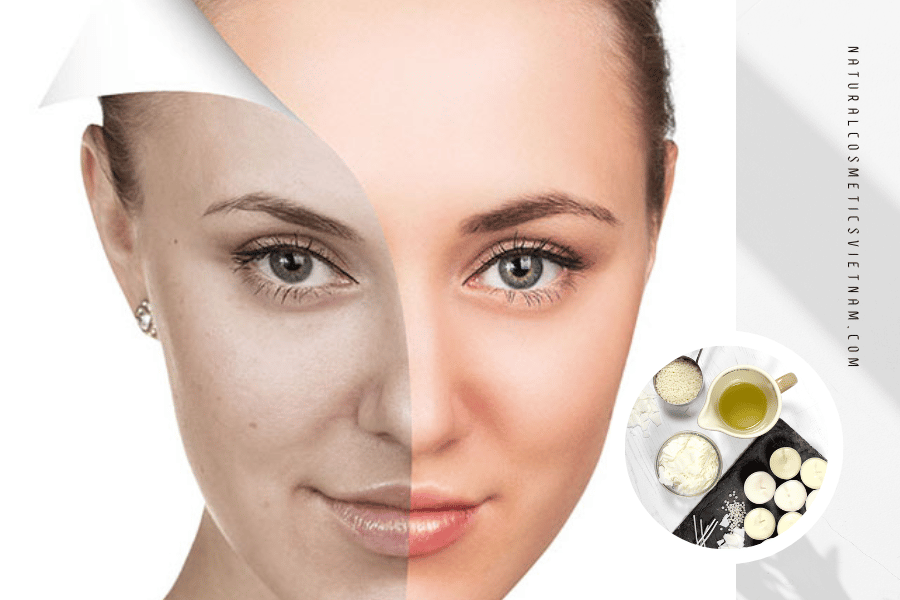
The benefits of waxes in natural cosmetics
Increasing Viscosity
Increasing viscosity is a significant benefit of natural waxes in skincare products. Natural waxes have the ability to thicken a product and give it more body. This property can be especially useful in formulations where a thicker, more substantial texture is desired. The increased viscosity also prevents the product from separating or becoming too runny, which can improve its overall stability and shelf life.
Natural waxes are often used as natural thickeners and emulsifiers in skincare products. These waxes can help create a smooth and creamy consistency that feels great on the skin. They also provide a protective barrier on the skin, helping to lock in moisture and protect against environmental pollutants. Increasing viscosity in skincare products can enhance the overall user experience by creating a luxurious and indulgent feeling. It can also improve the effectiveness of the product by ensuring it stays in place on the skin, allowing active ingredients to work their magic.
In conclusion, increasing viscosity is an important benefit of natural waxes in skincare formulations. Incorporating natural waxes like beeswax, candelilla wax, and carnauba wax into your skincare products can help create a thicker and more substantial texture, improving the overall user experience and effectiveness of the product. So, next time you’re formulating a skincare product, consider using natural waxes to enhance its viscosity and improve its performance.
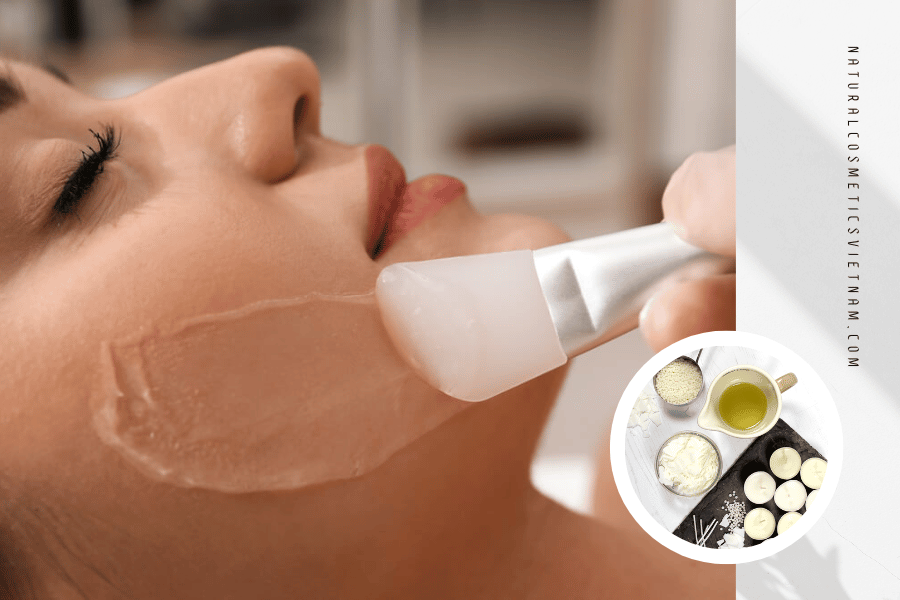
The benefits of waxes in natural cosmetics
Adding Shine
Adding shine is a significant benefit of natural waxes in skincare products. Natural waxes have the ability to create a glossy finish on a product, adding a subtle sheen to lotions, lip balms, and other skincare products. This property can enhance the overall appearance of the skin and make it look healthier and more radiant.
The natural waxes that are commonly used for adding shine in skincare products are those that have a glossy texture. These include beeswax, carnauba wax, and soy wax, among others. These waxes can help create a natural shine in products while also providing moisturizing benefits for the skin. When used in lip balms or other lip products, natural waxes can help create a glossy finish, making lips look plump and healthy. This is particularly useful in formulations where the goal is to create a natural, healthy appearance, such as with tinted lip balms.
In addition to adding shine, natural waxes can also improve the overall feel of a product. They can create a luxurious and indulgent experience for the user, making skincare routines more enjoyable and effective.
Adding shine is a significant benefit of natural waxes in skincare formulations. Whether you prefer beeswax, carnauba wax, soy wax, or another natural wax, incorporating these ingredients into your skincare products can help create a subtle sheen that enhances the overall appearance of the skin. So why not give them a try and see the difference they can make in your formulations today? With natural cosmetic waxes, you can create high-quality skincare products that not only improve the appearance of your skin but also feel great to use.
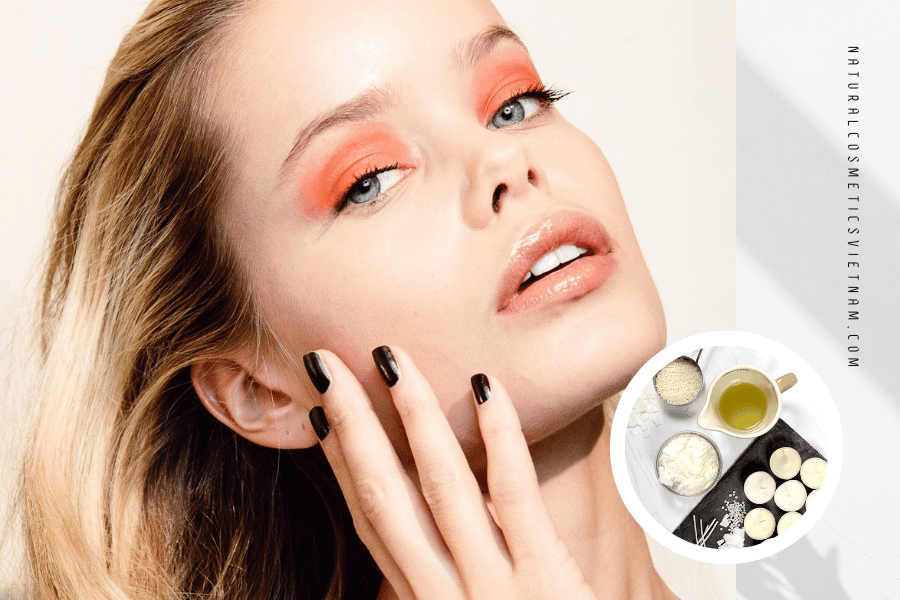
The benefits of waxes in natural cosmetics
Improving Hardness/Solidity
Improving hardness and solidity is another important benefit of natural waxes in skincare products. Natural waxes can help improve the overall stability and shelf life of a product by providing it with a more solid and stable structure. This property can be particularly important in formulations where the product needs to maintain its shape or form, such as with deodorants or solid perfumes. The natural waxes that are commonly used for improving hardness and solidity in skincare products are those that have a harder texture. Beeswax, carnauba wax, and candelilla wax are popular choices for improving the hardness and solidity of skincare products. These waxes can help the product maintain its shape and form, preventing it from melting or becoming too soft.
In addition to improving the overall stability and shelf life of a product, natural waxes can also enhance the user experience by providing a more substantial and luxurious feel. They can create a product that feels more substantial and substantial, making it more enjoyable and effective to use.
Improving hardness and solidity is an important benefit of natural waxes in skincare formulations. So why not give them a try and see the difference they can make in your formulations today?
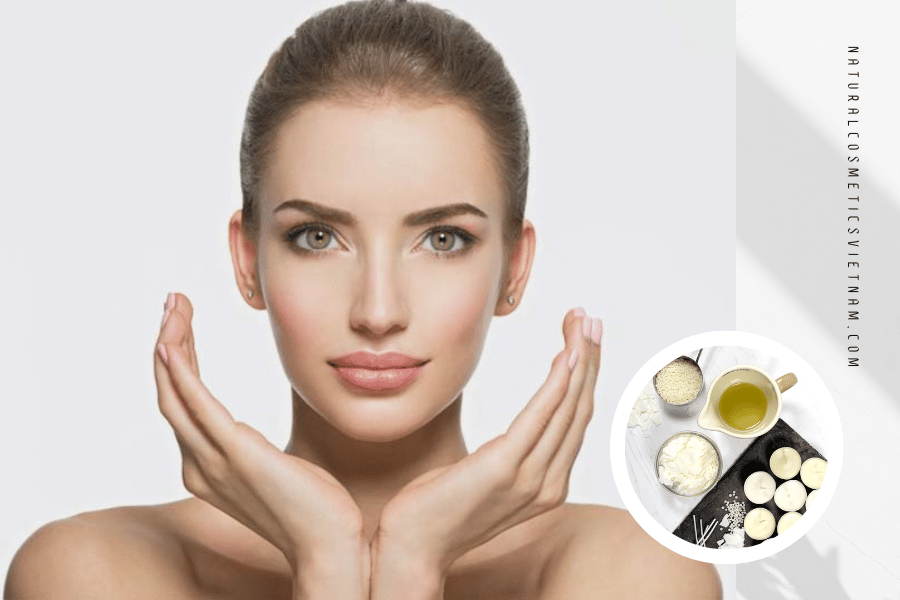
The benefits of waxes in natural cosmetics
Improving Overall Stability
Improving overall stability is one of the key benefits of natural waxes in skincare products. Natural waxes can help improve the stability and shelf life of a product by creating a more solid and stable structure. This property can be particularly important in formulations where the product needs to maintain its efficacy over a long period of time. The natural waxes that are commonly used for improving overall stability in skincare products are those that have a harder texture. We have many choices for improving the overall stability of skincare products. These waxes can help the product maintain its form and structure, preventing it from melting or separating.
In addition to improving the overall stability and shelf life of a product, natural waxes can also provide a protective barrier on the skin, helping to lock in moisture and protect against environmental pollutants. This can help improve the overall health and appearance of the skin over time.
Another way that natural waxes can improve overall stability is by serving as natural emulsifiers. Emulsifiers are ingredients that help bind oil and water-based ingredients together in a product, creating a stable and homogeneous mixture. Natural waxes like beeswax and candelilla wax have natural emulsifying properties, making them useful in formulations where oil and water-based ingredients need to be combined.
Improving overall stability is an important benefit of natural waxes in skincare formulations. Whether you prefer beeswax, carnauba wax, candelilla wax, or another natural wax, incorporating these ingredients into your skincare products can help create a more stable and effective product that provides protection and improves the overall health and appearance of the skin.
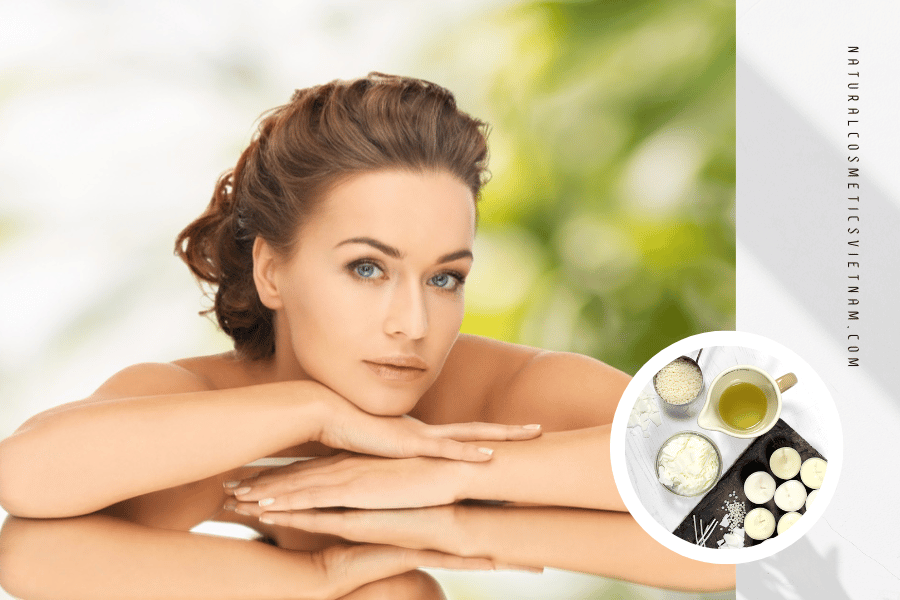
The benefits of waxes in natural cosmetics
Increasing/adjusting the melting point
Increasing or adjusting the melting point is another important benefit of natural waxes in skincare products. Natural waxes have the ability to change the melting point of a product, which can be useful in formulations where the product needs to maintain its consistency at different temperatures.
The melting point of a product is the temperature at which it changes from a solid to a liquid state. Natural waxes like beeswax, carnauba wax, and candelilla wax can help increase the melting point of a product, making it more resistant to high temperatures and ensuring that it maintains its shape and form. This property can be particularly important in formulations like lip balms or solid perfumes, which need to maintain their consistency at body temperature. By increasing or adjusting the melting point, natural waxes can help ensure that the product doesn’t melt or become too soft, making it easier to use and more effective.
In addition to increasing or adjusting the melting point, natural waxes can also provide other benefits to skincare products. They can help improve texture, increase viscosity, add shine, and improve overall stability, making them a versatile and multi-functional ingredient in skincare formulations.
Adjusting the melting point is an important benefit of natural waxes in skincare products. Whether you prefer beeswax, carnauba wax, candelilla wax, or another natural wax, incorporating these ingredients into your skincare products can help create a more stable and effective product that maintains its consistency and efficacy over time.
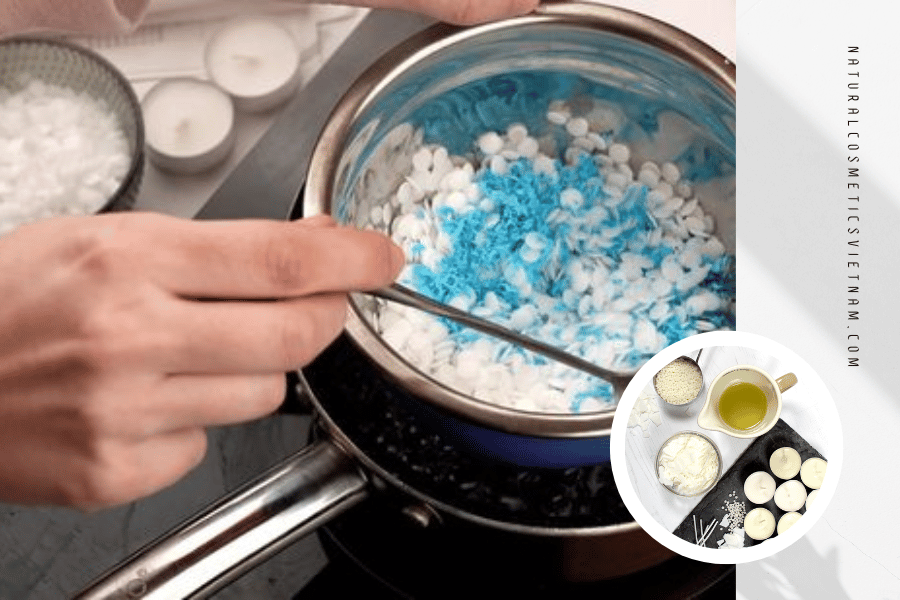
The benefits of waxes in natural cosmetics
The most common types of Waxes used in the cosmetics industry
Beeswax in cosmetics
Beeswax is a fascinating natural ingredient that has been used in various cosmetic and daily-use products for centuries. It is a type of wax that is produced by female worker bees who have wax-producing glands on their abdomen. The process of beeswax production is quite intricate and starts with the collection of flower nectar by the bees, which is then converted into honey through a series of enzymatic reactions within the bees’ bodies.
The bees consume the honey they have produced, which is then used to fuel the production of wax. The wax-producing glands on the abdomen of the female worker bees convert the sugar in the honey into wax, which is then secreted through tiny pores in their bodies as droplets that harden into wax when exposed to air. These droplets of wax sit as tiny, transparent flakes on the abdomen of the bees, and after being processed by the bee’s salivary secretions, the wax turns white and becomes soft and pliable enough to use as a construction material for the bees’ honeycomb. The honeycomb acts as a protective shield to keep out competing, raiding bee colonies, and pests. Beeswax is a crucial ingredient in the construction of the honeycomb, as it is both strong and malleable. The wax gradually changes color through the incorporation of honey, pollen, and propolis and darkens with age.
Beeswax is a versatile ingredient that is commonly used in cosmetic and personal care products due to its various benefits. It helps to improve texture, increase viscosity, add shine, and improve overall stability in formulations. Its emollient and moisturizing properties also make it a great addition to skincare products. However, bees are at risk of becoming an endangered species due to various factors such as habitat loss, pesticide use, and climate change. Therefore, it is crucial to source beeswax ethically and sparingly, if possible, from a local beekeeper whose beekeeping practices are transparent.
Despite its various benefits, it is essential to note that beeswax is not an emulsifier, as many formulators and students mistakenly believe. Using beeswax as an emulsifier can lead to instability and separation in formulations, and other natural emulsifiers should be used instead.
Beeswax is a natural and fascinating ingredient that has been used in cosmetics and other daily-use products for centuries. Its production process is intricate and relies heavily on the hard work of female worker bees. While beeswax remains a beautiful and functional ingredient, it is crucial to source it ethically and sparingly, as bees are essential to our ecosystem.
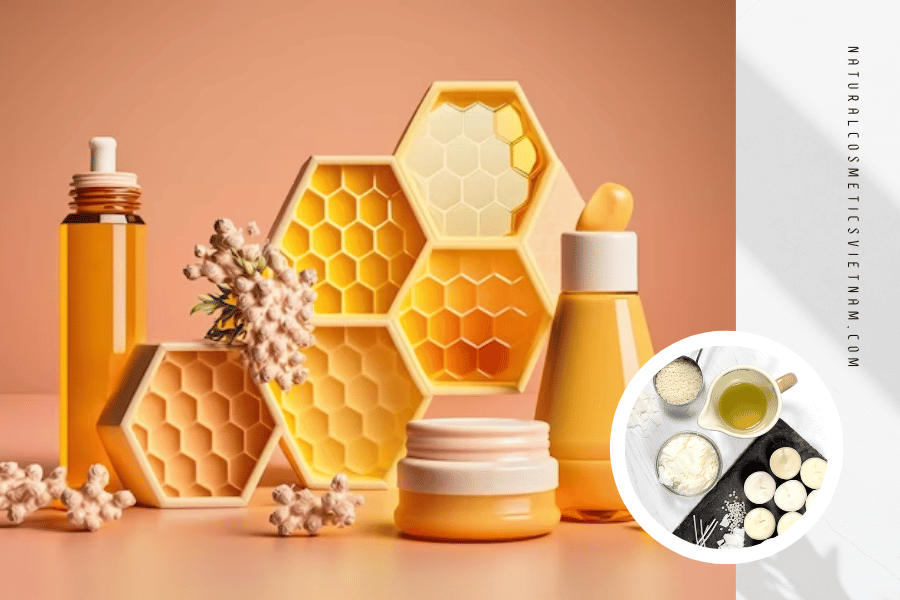
Beeswax in cosmetics
Vegan cosmetic waxes
Vegan waxes have become increasingly popular in the cosmetics industry, as they provide a sustainable and ethical alternative to traditional animal-derived waxes. These waxes are typically derived from leaves, peels, and fruits of different plants, or are separated from plant oils through the process of de-waxing.
De-waxing is a physical filtration process where the wax is separated or extracted from the plant material without the use of any chemical reactions. The extracted wax then goes through a process of refining and deodorizing to remove any unwanted scents or impurities. While the physical extraction and refinement of vegan waxes may seem intimidating to some, it is important to note that these processes do not involve any chemical reactions. However, some vegan waxes may undergo bleaching to make them whiter, which can be problematic for all-natural formulators. It is crucial for formulators to understand the different shades of natural in cosmetic formulating and to be aware of the potential pitfalls of using certain ingredients. Despite this, vegan waxes are considered true waxes as they are derived or extracted from plant materials or plant oils.
There are various types of vegan waxes available in the market, each with its own unique set of properties and benefits. These include carnauba wax, candelilla wax, rice bran wax, and soy wax, among others. Carnauba wax, for instance, is derived from the leaves of the carnauba palm and is known for its exceptional hardness and high melting point. Candelilla wax is derived from the leaves of the candelilla shrub and is commonly used as a vegan alternative to beeswax. Rice bran wax, on the other hand, is derived from the bran of rice and is known for its emollient and moisturizing properties. Soy wax is extracted from soybean oil and is often used in candle-making due to its clean-burning properties.
Vegan waxes are a sustainable and ethical alternative to traditional animal-derived waxes. These waxes are typically derived from plant materials or plant oils through the process of de-waxing, and are considered true waxes. Formulators should be aware of the different shades of natural in cosmetic formulating and choose ingredients that align with their values and formulations. With a variety of vegan waxes available, the possibilities for creating high-quality cosmetics are endless.
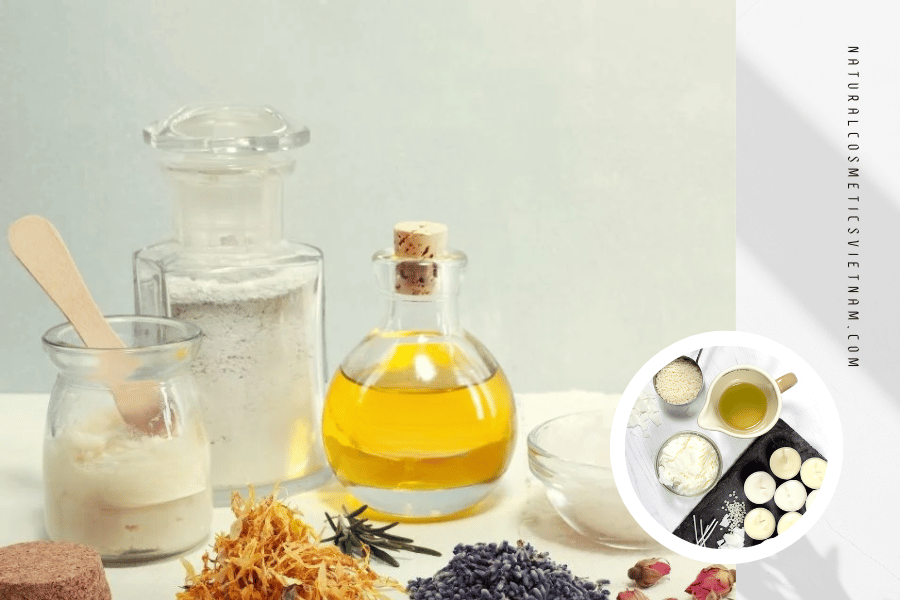
Vegan cosmetic waxes
Carnauba wax
Carnauba wax, also known as the “tree of life,” is a highly sought-after natural wax that is derived from the leaves of the Copernicia cerifera palm tree. This tree is native to the northeastern region of Brazil and is found along riverbanks, streams, and other wetland areas. The wax is produced by the tree as a protective mechanism against water loss in hot and dry environments. The wax is secreted through tiny pores on the fan-shaped leaves and is harvested during the dry season (July and August). After harvesting, the leaves are dried and crushed to extract the wax, which is then processed to achieve the desired color and quality.
Carnauba wax is one of the hardest and most durable natural waxes available, with a high melting point of 80-86°C, making it an ideal ingredient for personal care and natural cosmetic products. It has a natural sheen that enhances the appearance of products, making it a popular ingredient in lipsticks, lip balms, and other beauty products. Its ability to retain oils makes it an effective emulsifier, and it also creates a desirable level of viscosity in creams and lotions.
When used in high-end cosmetic formulations, carnauba wax enhances the melting point, increases viscosity, and improves color dispersion. It is often used in combination with other natural waxes, as well as natural and synthetic resins. Carnauba wax is a versatile and valuable natural ingredient that offers a range of benefits in various industries. Its exceptional hardness, high melting point, and compatibility with other natural and synthetic resins make it a popular choice among formulators. The sustainable harvesting practices of carnauba wax also make it a desirable choice for consumers who are concerned about the environmental impact of the products they use.
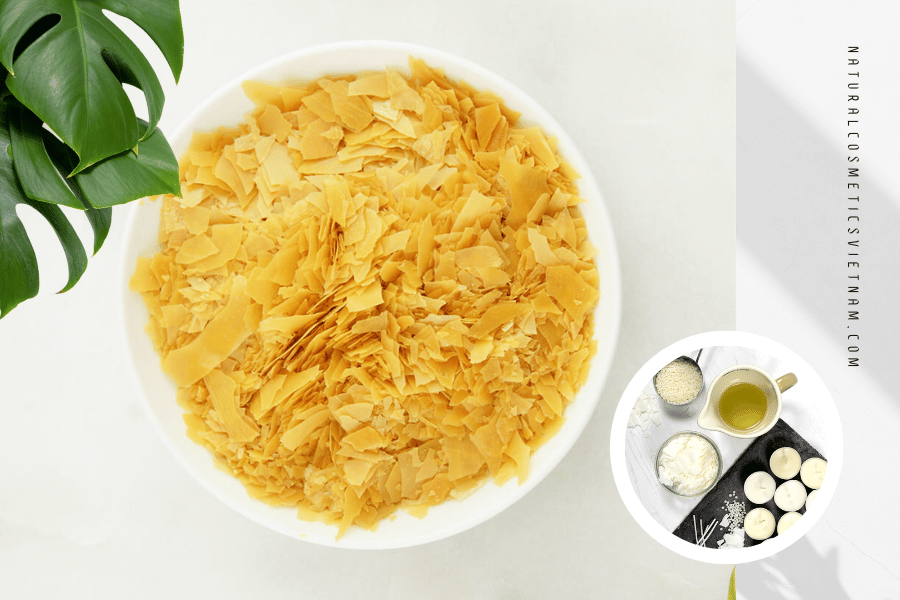
Carnauba wax
Myrica wax
Myrica wax is a natural wax derived from the fruit of the Myrica pubescens bush, which grows in the Andes region of South America. This wax has been used for centuries by indigenous communities for various purposes, including medicinal and cosmetic applications. The Myrica pubescens bush is an evergreen shrub that can reach up to 5 meters in height. It grows in high altitude areas where temperatures are low and humidity is high. The fruit of the bush is rich in wax, which is extracted using a simple, sustainable process.
Myrica wax is known for its unique properties, which make it an excellent ingredient in natural cosmetics. It has a low melting point, making it easy to work with, and it provides a smooth, velvety texture to skin care and makeup products. Myrica wax is also highly emollient, helping to moisturize and protect the skin from environmental stressors. One of the most significant benefits of Myrica wax is its sustainability. The wax is extracted from the fruit of the Myrica pubescens bush without harming the plant or the surrounding ecosystem. This makes Myrica wax a highly eco-friendly and sustainable ingredient for natural cosmetics.
As the demand for natural and sustainable cosmetics continues to grow, Myrica wax is becoming increasingly popular among formulators and consumers alike. Its unique properties and sustainability make it an excellent alternative to synthetic waxes, and its traditional use in indigenous communities adds a cultural dimension to its appeal.
In conclusion, Myrica wax is a valuable natural ingredient with a rich history and many benefits for both cosmetic and medicinal applications. Its sustainability and unique properties make it an attractive choice for natural cosmetic formulators and consumers looking for eco-friendly and effective products.
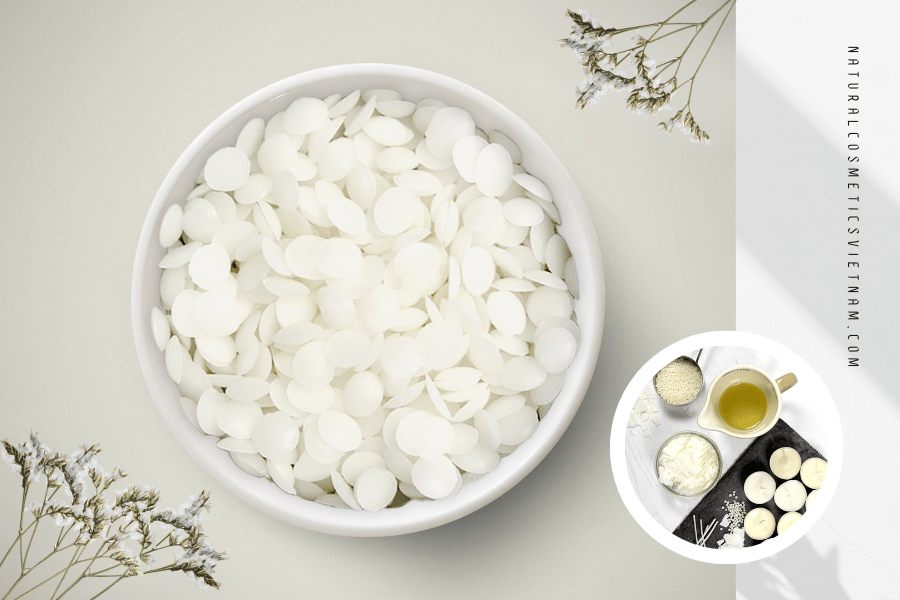
Myrica wax
Candelilla wax
Candelilla wax is a natural wax extracted from the Euphorbia antisyphillitica plant, which is a small shrub that grows in the Chihuahuan Desert of northeastern Mexico. The plant produces a wax coating in the form of grayish-green flakes on its small leaves and branches to limit water loss. As the weather gets hotter and drier, more wax is produced. The plant is classified as endangered and strictly regulated under the Convention on International Trade in Endangered Species of Wild Fauna and Flora (CITES). The wax is obtained by boiling the harvested plant, and then skimming off the wax that floats to the surface. The wax is then refined to remove impurities, water, and debris.
Candelilla wax is similar in appearance, shine, and hardness to carnauba wax, but has a lower melting point of 68.5-72.5°C and possesses unique characteristics. It has the ability to add hardness when used in combination with other waxes without increasing the melting point. This property also makes it an ideal ingredient for the production of lipsticks, lip balms, mascaras, and other cosmetics.
Candelilla wax has a wide range of applications in various industries. It is commonly used in the food industry as a coating for candy and other confections, and in the pharmaceutical industry as a coating for pills and tablets. The sustainable harvesting and extraction practices of candelilla wax make it an attractive ingredient for consumers who are concerned about the environmental impact of the products they use. In addition, its unique properties make it a desirable ingredient for formulators who are seeking natural alternatives to synthetic ingredients.
Overall, candelilla wax is a valuable and versatile natural wax that offers a range of benefits in various industries. Its unique properties and sustainable sourcing make it an attractive choice for consumers and formulators alike.
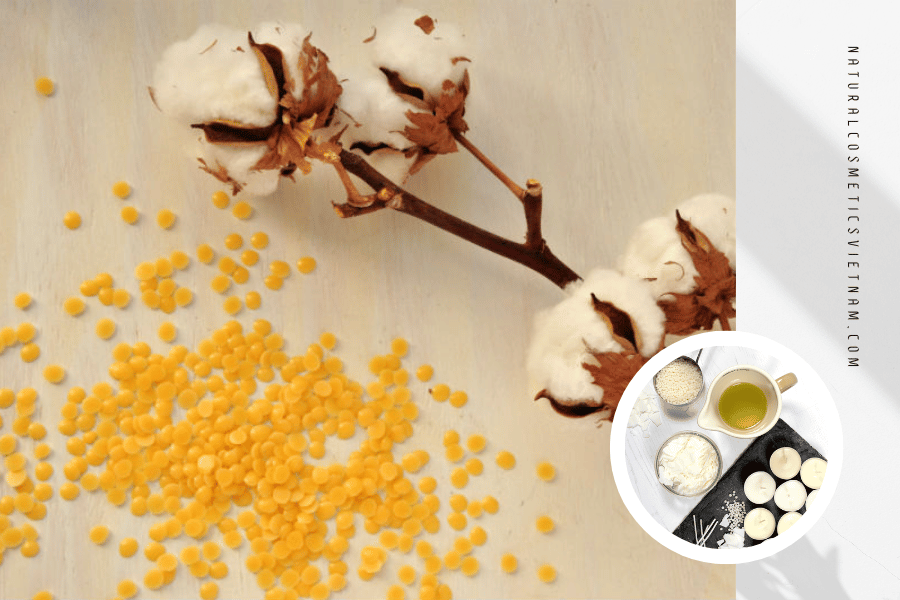
Candelilla wax
Cinnamon wax (Laurel wax)
Cinnamon wax, also known as berry wax, is a natural wax extracted in a water form that is greenish in color, derived from the fruit of the Myrica pubescens bush. The wax is inherently hard but has a low melting point of 38-46 oC, making it a highly valued soap-making ingredient. Cinnamon wax is widely used in natural skincare and hair care products due to its high stability.
One of the most significant contributions of cinnamon wax is its ability to create product structure and provide a pleasant, non-greasy feel when used. Additionally, cinnamon wax is capable of softening and smoothing the skin without leaving a greasy or sticky feeling. It also has excellent shine properties, making it popular in lip balm formulations. Cinnamon wax is also used to increase the viscosity of oil-in-water emulsions without the need for other additives.
Cinnamon wax can be used as a replacement for animal-derived beeswax or other animal waxes in vegan cosmetics formulations. Its unique properties make it a popular ingredient in natural skincare and hair care products, as it provides various benefits while remaining vegan-friendly. The use of cinnamon wax is also a sustainable alternative, as it is derived from renewable plant sources.
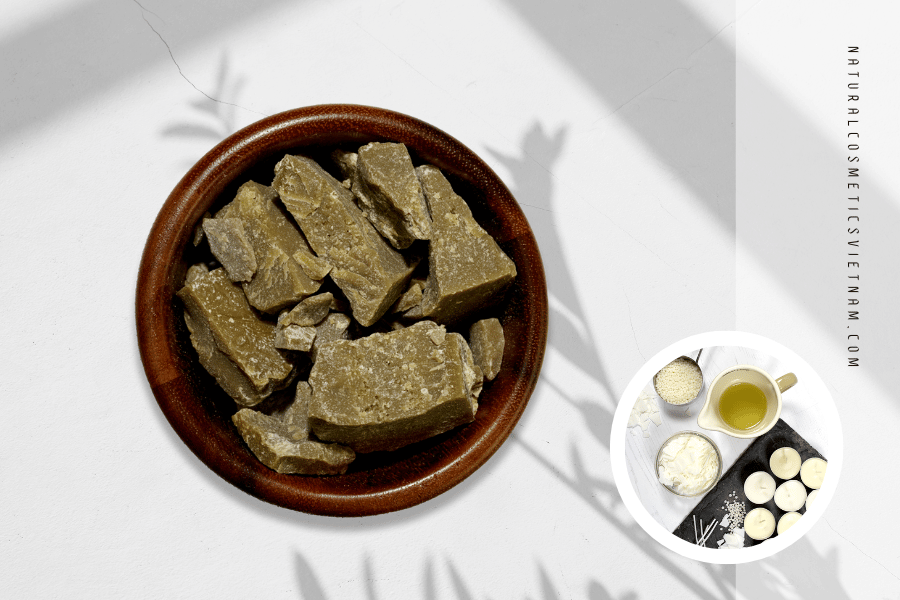
Cinnamon wax (Laurel wax)
Genuine rice bran wax (Rice bran wax)
Rice bran wax is a natural wax obtained from the bran or outer layer of rice grains. It is a pale yellow wax with excellent hardness and gloss properties, and a high melting point of 79-85°C. Rice bran wax is extracted from the de-oiling process of rice bran, rather than being a hydrogenated derivative of rice bran oil.
In addition to its excellent binding properties, rice bran wax is also known for its emulsifying and thickening properties. Rice bran wax is particularly effective in binding oils in cosmetic formulations, especially in stabilizing oils in both emulsions and suspensions. Additionally, it is commonly used as a thickening, foaming, and gelling agent in cosmetic formulations. Typically, rice bran wax is used at concentrations below 1% in formulations. It is commonly used in personal care products such as creams, lotions, and lip balms. Its emulsifying properties allow it to mix oil and water-based ingredients together, which is important in creating stable emulsions in skincare formulations. Rice bran wax is also a popular choice as a thickening agent in personal care formulations. It can be added in small amounts to thicken the consistency of a product, which helps to improve its texture and overall performance. Additionally, it can be used as a foaming agent to create luxurious lather in products like shampoos and body washes.
Due to its natural origin, rice bran wax is a desirable ingredient in natural and organic personal care products. Its properties make it an excellent alternative to synthetic waxes like petroleum-derived paraffin wax or synthetic beeswax. It is also a vegan-friendly option, making it ideal for use in formulations for consumers who prefer vegan products.
Rice bran wax is a versatile and functional ingredient in personal care products. Its unique properties make it an excellent choice for binding, emulsifying, thickening, and foaming. Its natural origin and vegan-friendly status make it an ideal choice for formulators looking to create natural and sustainable products.
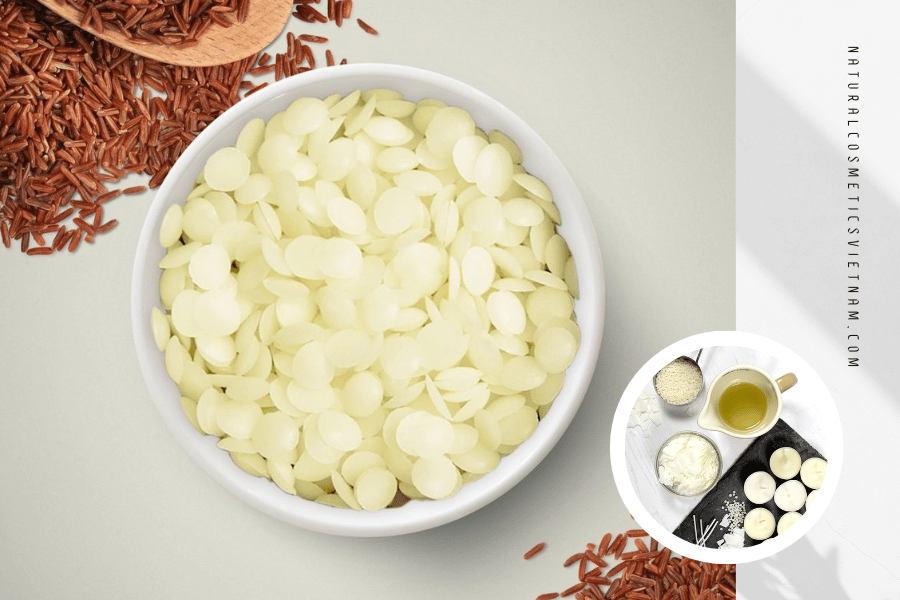
Genuine rice bran wax (Rice bran wax)
Differences in natural cosmetic waxes
As part of our community, we frequently receive questions about the optimal usage and proportion of natural cosmetic waxes. To help you navigate through this challenge, we conducted a series of comparative tests to assess different types of waxes and determine the appropriate ratios to use in your own formulations. It is important to note that the percentage of wax used may vary depending on the type of formulation, such as stick products like facial cleansing sticks, lip balms in jars, and whipped lip scrubs. For the purpose of this article, we will be focusing on anhydrous balms in a jar.
We will be conducting tests on six various types of waxes:
- Myrica wax (INCI myrica cerifera fruit wax): melting point 45-55°C
- Berry wax (INCI rhus verniciflua peel cera): melting point 48-54°C
- Beeswax (INCI cera alba): melting point 61-65°C
- Candelilla wax (INCI euphorbia cerifera cera): melting point 68-73°C
- Rice bran wax (INCI oryza sativa cera): melting point 79-85°C
- Carnauba wax (INCI copernicia cerifera cera): melting point 80-86°C
In this part, we will discuss three categories of natural cosmetic waxes and provide general recommendations for their use in different formulations. There is a significant variation in the melting points of these waxes, and for simplicity, we will categorize them into three groups:
Soft waxes: Myrica wax and berry wax
Myrica wax is a natural wax derived from the Myrica pubescens bush, which is native to Central and South America. This wax is soft and has a low melting point, making it ideal for use in emollient and moisturizing products like lip balms, creams, and lotions. Similarly, berry wax is extracted from the berries of the Rhus verniciflua tree, which is native to China and Japan. Berry wax is also soft and has a low melting point, making it suitable for use in emollient and moisturizing products. While these waxes are not suitable for use as standalone waxes to create hard stick formulations, they work well in combination with medium or hard waxes to achieve the desired consistency. For best results, we recommend using 5-30% of these waxes in a jar or a stick formulation.
Medium waxes: Beeswax and candelilla wax
Beeswax is one of the most commonly used waxes in natural cosmetic formulations. It is derived from the wax-producing glands of worker bees and is known for its emollient and moisturizing properties. Similarly, candelilla wax is a plant-based wax derived from the leaves of the candelilla shrub, which is native to Mexico and the southwestern United States. Candelilla wax is also known for its emollient and moisturizing properties. These waxes have a higher melting point than soft waxes, making them suitable for use in stick formulations like lip balms and deodorants. For best results, we recommend using 5-20% of these waxes in a jar formulation and 10-30% in a stick formulation.
Hard waxes: Rice bran wax and carnauba wax
Rice bran wax is a natural wax derived from rice bran oil, which is extracted from the outer layer of rice grains. This wax has a high melting point and is known for its thickening and stabilizing properties. Similarly, carnauba wax is a plant-based wax derived from the leaves of the Brazilian carnauba palm. This wax is also known for its thickening and stabilizing properties and has the highest melting point of all natural waxes. While these waxes are not suitable for use in emollient or moisturizing products, they are ideal for use in hard stick formulations like lipsticks and balms. For best results, we recommend using less than 5% of these waxes in a jar formulation and 5-10% in a stick formulation.
The categorization of waxes into soft, medium, and hard types helps us understand why it’s not a good idea to add a high percentage of hard wax to products, even in stick formulations. To illustrate this point, I conducted a fun experiment with the following formulation:
- 40% carnauba wax
- 30% shea butter
- 29.5% grapeseed oil
- 0.5% vitamin E
As you can see, 40% carnauba wax is an extremely high amount, especially considering that carnauba wax is a hard wax. In fact, it’s generally recommended to use less than 5% carnauba wax in a jar formulation and 5-10% in a stick formulation. By adding such a high percentage of carnauba wax, the resulting product would be too hard and difficult to use. By understanding the characteristics and recommended usage rates of different waxes, we can create effective and enjoyable natural cosmetic formulations.

Differences in natural cosmetic waxes
Natural cosmetic waxes are an essential ingredient in any organic skincare routine. Whether you’re looking to improve texture, increase viscosity, add shine, improve hardness and stability, or adjust the melting point of a product, natural waxes offer a range of benefits that can help you achieve your skincare goals. So why not give them a try and see the difference they can make in your formulations today?










Leave a reply